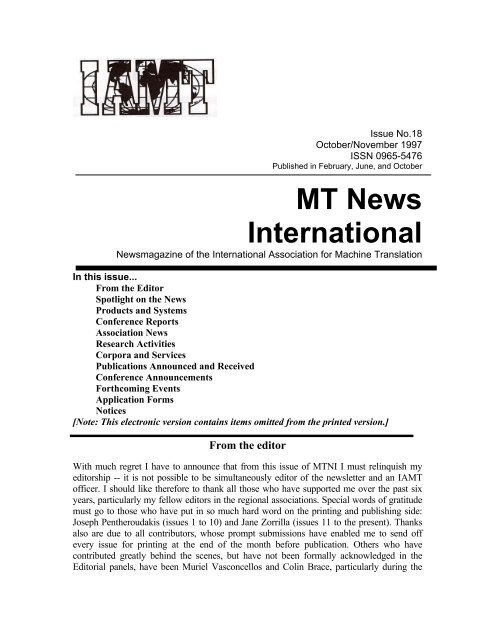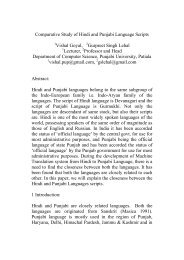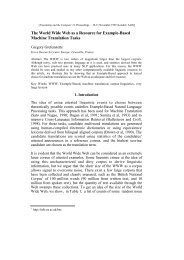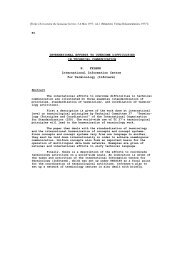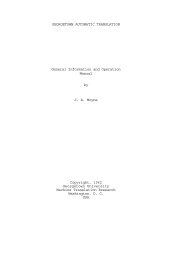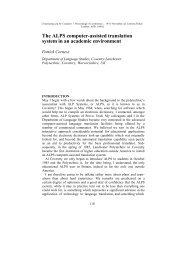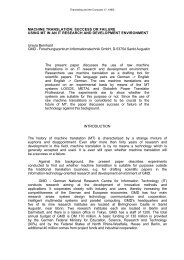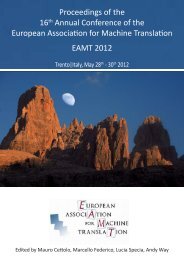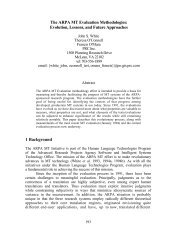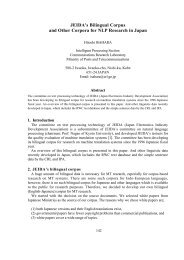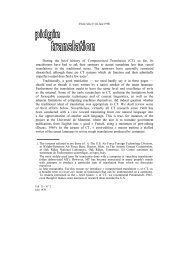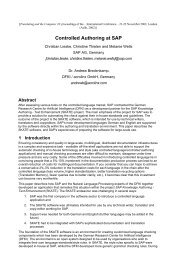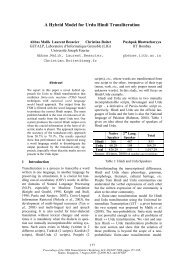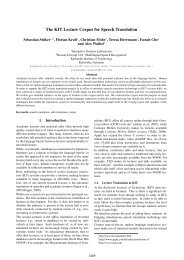MT News International no.18 - Machine Translation Archive
MT News International no.18 - Machine Translation Archive
MT News International no.18 - Machine Translation Archive
Create successful ePaper yourself
Turn your PDF publications into a flip-book with our unique Google optimized e-Paper software.
Issue No.18<br />
October/November 1997<br />
ISSN 0965-5476<br />
Published in February, June, and October<br />
<strong>MT</strong> <strong>News</strong><br />
<strong>International</strong><br />
<strong>News</strong>magazine of the <strong>International</strong> Association for <strong>Machine</strong> <strong>Translation</strong><br />
In this issue...<br />
From the Editor<br />
Spotlight on the <strong>News</strong><br />
Products and Systems<br />
Conference Reports<br />
Association <strong>News</strong><br />
Research Activities<br />
Corpora and Services<br />
Publications Announced and Received<br />
Conference Announcements<br />
Forthcoming Events<br />
Application Forms<br />
Notices<br />
[Note: This electronic version contains items omitted from the printed version.]<br />
From the editor<br />
With much regret I have to announce that from this issue of <strong>MT</strong>NI I must relinquish my<br />
editorship -- it is not possible to be simultaneously editor of the newsletter and an IA<strong>MT</strong><br />
officer. I should like therefore to thank all those who have supported me over the past six<br />
years, particularly my fellow editors in the regional associations. Special words of gratitude<br />
must go to those who have put in so much hard word on the printing and publishing side:<br />
Joseph Pentheroudakis (issues 1 to 10) and Jane Zorrilla (issues 11 to the present). Thanks<br />
also are due to all contributors, whose prompt submissions have enabled me to send off<br />
every issue for printing at the end of the month before publication. Others who have<br />
contributed greatly behind the scenes, but have not been formally acknowledged in the<br />
Editorial panels, have been Muriel Vasconcellos and Colin Brace, particularly during the
last two years. Although I shall no longer be editor, it is my hope that I can continue to write<br />
contributions of various kinds to future issues of the newsletter. I wish my successor every<br />
success in the continuation of a publication which has, I believe, not only established itself<br />
as the principal forum for the <strong>International</strong> Association for <strong>Machine</strong> <strong>Translation</strong> but which is<br />
now also seen as a major source of information about contemporary developments in<br />
machine translation and computer-aided translation systems throughout the world.<br />
SPOTLIGHT ON THE NEWS<br />
Microsoft to Acquire a 20 Percent Share in TRADOS<br />
John Hutchins<br />
September 1997<br />
[Press release]<br />
REDMOND, Wash., Sept. 9 -- Microsoft Corporation today announced it plans to acquire<br />
a 20 percent minority share of TRADOS GmbH, of Stuttgart, Germany, in a move<br />
designed to accelerate the delivery of localized software products.<br />
TRADOS products are utilized extensively by the software industry to create<br />
foreign-language "localized" software products. Microsoft ships its products in more than<br />
30 languages, and the investment in TRADOS reflects a commitment to quickly and<br />
efficiently deliver localized products internationally.<br />
"Investing in TRADOS technology will secure our ability to produce high-quality<br />
localized products in the most cost-effective manner," said Franz Rau, director of internal<br />
tools at Microsoft. "This investment will allow us to work with TRADOS to keep in step<br />
with Microsoft's evolving needs."<br />
Microsoft plans to use TRADOS software as its internal localization memory<br />
store. This will allow Microsoft to more effectively reuse already localized text from<br />
product to product. The minority share in TRADOS further solidifies the relationship<br />
between the two companies. As part of the agreement, Microsoft has also signed a longterm<br />
support-and-development contract to service Microsoft-specific needs. TRADOS<br />
expects this move will enable it to step up the pace for new product development.<br />
"Our relationship with Microsoft will allow TRADOS to consolidate and expand<br />
its position as a worldwide leader in translation tools," said Iko Knyphausen, CEO of<br />
TRADOS.<br />
"Having the benefit of a strong investor is important to us at this stage of the<br />
development of the company," said Jochen Hummel, president of TRADOS. "We'll be<br />
able to take advantage of Microsoft's experience and keep up our 100 percent growth rate<br />
of the past three years."<br />
For more information, visit http://www.trados.com/, or call TRADOS Corp. in the<br />
United States at 703-683-6900. In Europe, call TRADOS GmbH at 49-711-168-770.
PRODUCTS AND SYSTEMS<br />
Linguistics Products Improves PC-TRANSLATOR<br />
PC-TRANSLATOR is now available under Microsoft Windows, and (when supplied<br />
with sixteen of the available eighteen language pairs) on a single CD. Its dictionary editor<br />
is dramatically improved and its speed, with a Pentium PC, is much faster. It is also more<br />
user-friendly, and a substantial price reduction has made it far more affordable, while the<br />
need to consult its manual has almost been eliminated with Windows Help Screens. One<br />
of PC-TRANSLATOR's features, its ability to preserve the formatting of WordPerfect<br />
and Microsoft Word (RTF) text files, can produce similar results when it is used to<br />
translate Windows Help Screens.<br />
Developments of PARS systems<br />
Michael Blekhman<br />
From English into East Slavonic languages<br />
Translating Internet files<br />
Lingvistica '93 Co. have come up with the new versions of the bidirectional PARS<br />
and PARS/U <strong>MT</strong> systems, for translating between English and Russian and English and<br />
Ukrainian, respectively. The first thing to point out is that PARSes now translate not only<br />
WinWord, but also HTML files. Correspondingly, the user selects either the "MS Word" or<br />
the "HTML" mode in PARS options. To have an HTML text translated, he/she displays the<br />
text using, for example, Netscape Navigator, copies the text portion to be translated to the<br />
clipboard, and activates PARS. The system main window is displayed, in which the user<br />
may set up the combination of dictionaries to be used in the translation session. It is<br />
important that the system saves the configuration, so there is no need to make the settings in<br />
each translation session: PARS will behave the way it did before.<br />
The translation lasts for about 2-3 sec. per page (250 words) on a Pentium-type<br />
computer, and the target text is pasted in a special under the source text. The polysemantic<br />
words are marked with asterisks in the target text, which is one of PARS "visiting cards": a<br />
double click on the asterisk displays translation options, another double click on a more<br />
appropriate variant substitutes the initial one in the text. At the same time, if the user does<br />
not want to see the asterisks in the translation, he/she may simply disable the "translation<br />
variants" mode. The target text may be saved in a file for further editing, if required.<br />
Another point of importance is that PARSes can translate screen Helps in the same way.<br />
Both PARSes are marketed in North America: PARS by Virginia-based<br />
POLYGLOSSUM, Inc., and PARS/U by Erudite Corp., Toronto, Canada.<br />
As to the ex-Union market, PARS is becoming one of the most (if not the most)<br />
popular systems in Russia. It is distributed by Moscow-based ETS Publishers Ltd. on CD-<br />
ROM together with Polyglossum dictionaries. The disks are extremely cheap, which makes<br />
them accessible to broad public. The prices are between $15 to $30, and the disks are sold<br />
practically at each Moscow computer and software shop. In 1996, about 10,000 disks were<br />
sold and placed at dealers.
Lexicographic work<br />
PARS is a very large project aimed at covering all subject areas in science and<br />
technology. Presently, PARS terminological dictionaries comprise over 700,000 wordentries<br />
in each part, English-Russian and Russian-English. Dictionaries on mathematics<br />
(80,000), automobile building (50,000), and chemistry have been added to PARS using<br />
Lingvistica '93 know-how, which includes automatic assigning grammatical information to<br />
Slavonic words.<br />
Also, the PARS/Avia project is under way, on the order of the Ukrainian giant,<br />
O.Antonov Aviation Design Bureau. The task is to make PARS capable of producing draft<br />
translations of aviation documentation from Russian into English and save human efforts at<br />
least 2-3 times. The first stage of the project (to be finished in April) consists in compiling a<br />
set of specialized dictionaries on various aspects of aircraft engineering.<br />
The second stage will include developing a large documentation management<br />
system that will comprise PARS as a translation module. Other modules will be a database<br />
management system, an OCR program, and a specialized text editor.<br />
Under the Polyglossum project, Lingvistica '93 and ETS Publishers Ltd. are<br />
developing two large general dictionaries to be distributed on compact disks later this year:<br />
German-Russian-German and French-Russian-French.<br />
A German-Russian Bidirectional <strong>MT</strong> System<br />
Lingvistica '93 has developed a new <strong>MT</strong> system in the 'PARS' series - PARS/Deutsch 1.0 -<br />
for translating between German and Russian. The system runs under Windows 3.1 and<br />
Windows 95. It can be started directly from MS Word 6.0 or MS Word 7.0, and it also<br />
translates HTML and Windows texts such as screen Helps.<br />
We began developing a German to Russian <strong>MT</strong> system back in 1993, on the order of<br />
the Izvestia Concern, Moscow, Russia. It was supposed to run under DOS and produce draft<br />
translations of socio-political texts such as information messages by the VWD Agency. The<br />
prototype version was released in 1994, having a basic dictionary of 18,000 words and<br />
phrases.<br />
In April 1997 work resume with financing from Igor Jourist Verlag, Germany.<br />
Within 5 months, a Windows bidirectional system was made based on the main PARS<br />
principles and having 3 dictionaries: general (23,000 words and phrases in each part,<br />
German-Russian and Russian-German); business (13,000); medical (8,000), made out of the<br />
corresponding Polyglossum dictionary compiled by ETS Publishers, Russia.<br />
PARS/D shares the features of other PARS systems, together with various<br />
peculiarities due to specific features of German spelling and grammar.<br />
For more information: Dr. Michael S. Blekhman, Director, Lingvistica '93 Co., 94a<br />
Prospekt Gagarina, apt. 111, Kharkov 310140, Ukraine. (Tel.: +380 (0572) 27-71-35;<br />
Email: blekhman@kpi.kharkov.ua or: blekhman@lotus.kpi.kharkov.ua)<br />
==============================================================<br />
CONFERENCE REPORTS<br />
TMI-97 meets in Santa Fe<br />
23-25 July 1997<br />
John Hutchins
The magnificent surroundings of mountainous northern New Mexico was the invigorating<br />
setting for the Seventh <strong>International</strong> Conference on Theoretical and Methodological Issues<br />
in <strong>Machine</strong> <strong>Translation</strong>. The program combined the usual wide range of reports on current<br />
research activity with some retrospective reflections occasioned by the marking in 1997 of<br />
fifty years since Warren Weaver first suggested that computers might be used to translate<br />
natural languages.<br />
In this spirit, the program included two speakers from the earliest period of machine<br />
translation and computational linguistics. Victor Yngve had been the head of the research<br />
project at MIT from 1953 until the mid 1960s. He told us about the directions of research at<br />
that time, his discussions with Noam Chomsky (then a member of the same research<br />
laboratory), and the development of the first non-numerical programming language COMIT.<br />
This was a prelude to a description of his more recent work on the theoretical foundations of<br />
a new approach to linguistics, based on truly scientific principles and not distorted by false<br />
assumptions going back to the earliest speculations by Greek philosophers. It was his belief<br />
that <strong>MT</strong> researchers could be more open to new ideas and methods than traditional<br />
linguistics, as demonstrated by their adoption of corpus-based approaches. Yngve's radical<br />
re-formulation of linguistics could not of course be expounded in the span of a relatively<br />
short conference paper, but we were urged and inspired to read his recently published book<br />
(From grammar to science. Amsterdam: John Benjamins, 1996).<br />
The second speaker was George Miller, who had been involved with <strong>MT</strong> and<br />
information retrieval at Harvard University. His subsequent career had ranged over virtually<br />
the whole spectrum of computational linguistics and cognitive science, but recently he has<br />
become best known for the creation and development of WordNet. He devoted his talk to<br />
describing his current research on 'computer-assisted reading'. The basic idea is that children<br />
would learn to read from an electronic text where every substantive word would be linked to<br />
dictionary and encyclopedia entries. It would help children to understand any words they<br />
have difficulty with, and to build up their vocabulary. The idea has obvious wider<br />
applications, for students reading science textbooks, and for students learning foreign<br />
languages. The relevance of corpus-based <strong>MT</strong> research to the latter was obvious, and Miller<br />
encouraged participants to investigate this and other potential applications of their work.<br />
One other speaker also informed the conference about earlier research. This was<br />
John Hutchins in a talk devoted to describing the beginnings of <strong>MT</strong> activity in the 1940s and<br />
in particular the events during and after the first <strong>MT</strong> conference in 1952. Otherwise, all<br />
speakers chose to speak about their own current and forthcoming research.<br />
As might be expected, the host organisation (CRL, NMSU) was well represented. A<br />
joint paper by Kavi Mahesh, Sergei Nirenburg and Stephen Beale described word sense<br />
disambiguation using relationships in a domain knowledge base. The topic was taken up in a<br />
second paper by the same group presented by Stephen Beale.<br />
Research for speech translation was a dominant topic. Shigeki Matsubara and<br />
Yasuyoshi Inagaki (Nagoya University) outlined a method of incremental parsing, transfer<br />
and generation taking English spoken input sequentially and producing Japanese output<br />
before sentence completion. Hideki Mima presented a paper from ATR on tackling<br />
problems of Japanese honorifics in spoken dialogue translation, applying situational<br />
knowledge in a basically transfer-driven <strong>MT</strong> model. There were two reports from the<br />
Verbmobil project: Birte Schmitz (Technical University Berlin) on the identification of turn-
taking markers in dialogue, and Jan W. Amtrup (University of Hamburg) on a unificationbased<br />
architecture suitable for spontaneous speech.<br />
The problem of 'natural' generation was tackled by Shiho Ogino and Tetsuya<br />
Nasukawa (IBM Tokyo), describing a method based on shallow discourse analysis; by<br />
Eduard Hovy and Laurie Gerber on using paragraph structure to improve Systran output;<br />
and by Karin Harbusch (University of Koblenz) who sought to define how discourse<br />
representation theory might be satisfactorily introduced into <strong>MT</strong> systems; and Antonio<br />
Sanfilippo (Sharp Laboratories, Oxford) suggested a thesaural approach to lexical selection.<br />
The application of <strong>MT</strong> on the Web was the theme of Yumiko Yoshimura and<br />
colleagues from Toshiba, who described a method for Japanese Web browsers to identify<br />
English texts on sought subjects by means of proper nouns and statistical keyword analysis.<br />
Francis Bond and colleagues described research for the NTT Japanese-English<br />
system in two papers: one on the analysis of temporal expressions (dates, time of day,<br />
weeks, months, etc.), and the other on the treatment of adverbial expressions. On similar<br />
practical lines was the paper from Kazunori Muraki and his NEC colleagues on lexical<br />
frames for selecting Japanese verbs<br />
Efforts to improve <strong>MT</strong> quality were evident in many papers. Kanlaya Naruedomkul<br />
and Nick Cercone (University of Regina) described an iterative approach to quality<br />
improvement, using a combination of HPSG parser, selection constraints and word order<br />
patterns. The languages involved are Thai and English.<br />
The control of input was the theme of Anna Sågvall Hein (Uppsala University), who<br />
described the Multra system for generating English and German translation for the Scania<br />
company from Swedish documents (some 6,000 pages in 1996). A checker for a controlled<br />
language 'ScaniaSwedish' has been developed based on the analysis component of the <strong>MT</strong><br />
system.<br />
Two papers from Spanish researchers were devoted to the finite-state neuralnetwork<br />
model under investigation for the European Union-funded project EuTrans,<br />
basically an example-based system for Spanish and English. The claim is that 'subsequential<br />
transducers' are conceptually simple but computationally powerful finite-state models<br />
capable of incremental improvement from training data.<br />
Other aspects of example-based approaches were discussed in papers by Ralf D.<br />
Brown (Carnegie Mellon University), on using statistical methods for dictionary extraction<br />
for the DIPLOMAT system; and by Brona Collins and Padraig Cunningham (Trinity<br />
College Dublin), on the use of 'adaptation knowledge' of previous successful matches. The<br />
more general problem of word alignment in bilingual corpora was tackled by Mathis Chen<br />
and others from the National Tsing Hua University, Taiwan, arguing for the use of 'topical'<br />
clustering of bilingual dictionary entries.<br />
Arturo Trujillo (UMIST) described a method for improving chart generation in a<br />
lexicalist approach. The shake-and-bake approach was also the inspiration for the work of<br />
Fred Popowich and co-workers at Simon Fraser University and TCC Communications. The<br />
goal is a system for on-line translation of television captions and subtitles from English into<br />
Spanish (and later other languages). An obvious challenge is the treatment of colloquial and<br />
idiomatic language with high level of ambiguity, and within an unrestricted domain. On the<br />
other hand, recipients have the help of the visual images for understanding. It is further<br />
demonstration of the ever widening field of automatic translation to areas inconceivable to<br />
the pioneers of the 1940s and 1950s.
The final highlight of the conference was a 'dialogue' between Yorick Wilks and<br />
Sergei Nirenburg on "What's in a symbol? Ontology and the surface of language.” Each put<br />
their different views on a series of issues, including, e.g. the nature of representations<br />
languages (are they natural languages or not? are they as ambiguous as natural language?<br />
are their primitives NL words or word senses?); their extensibility; the relation between NL<br />
and RL (is it that of language and metalanguage?); the differences between representation<br />
for human users/developers and representation for machines; and much more besides. Such<br />
was the depth and importance of the questions raised and the insights brought to them by<br />
both disputants that it is very much to be hoped that this dialogue is published in the near<br />
future for the benefit of everyone (and not just those fortunate to have been in Santa Fe in<br />
July 1997.)<br />
TMI-97 was undoubtedly another successful conference in this continuing important<br />
series. It was ably and efficiently organised by the Computing Research Laboratory, New<br />
Mexico State University (Las Cruces) under the general chairmanship of Sergei Nirenburg.<br />
Harold Somers (UMIST) was the program chair, who is to be congratulated for bringing<br />
together an excellent group of speakers for the seventh of this series of successful biannual<br />
conferences.<br />
The Spoken Language <strong>Translation</strong> Workshop<br />
ACL/EACL-97, 11 July 1997, Madrid<br />
Steven Krauwer, Doug Arnold, Walter Kasper,<br />
Manny Rayner, Harold Somers<br />
One of the many workshops organized in conjunction with the joint ACL/EACL<br />
Conference in Madrid this summer was dedicated to Spoken Language <strong>Translation</strong><br />
(SLT).<br />
The workshop was co-organized by ELSNET (the European Network in<br />
Language and Speech) and the editors of the journal <strong>Machine</strong> <strong>Translation</strong>. It attracted 40<br />
participants and the programme included twelve presentations and three posters. Twelve<br />
out of fifteen contributions originated from the Far East and from Europe (six each), and<br />
three from the US. The workshop had four sections.<br />
Exploiting and Exploring Dialogue Structure.<br />
Dialogue <strong>MT</strong> introduces interesting problems beyond the already difficult issues<br />
of integrating speech processing with translation. As has clearly been recognised in the<br />
three papers which made up this opening session, identifying the special pragmatic<br />
features of spoken dialogue which distinguish such ``texts'' from the type of input that a<br />
traditional <strong>MT</strong> system might deal with is a crucial part of the problem. Traditionally, the<br />
incorporation of contextual knowledge into an <strong>MT</strong> system was just dismissed as<br />
impractical, or at best, uneconomical. In a dialogue system, such an approach is<br />
unthinkable.<br />
Manfred Stede and Birte Schmitz initiated the workshop with a close look at<br />
“discourse particles”, the little words which can carry so much meaning, especially in<br />
terms of the overall dialogue structure. An additional problem is that many of these<br />
particles are ambiguous in that they also have an interpretation not related to discourse<br />
structure. Jae-won Lee looked at words whose translation is particularly dependent on the
context, a problem which is exacerbated in a language-pair such as Korean--English.<br />
Their approach is to apply a statistical model of dialogue structure based on trigrams of<br />
speech acts. Keiko Horiguchi discussed meaningful ``errors'' in speech which convey<br />
contextual meaning or the speaker's attitude, and then focused on the translation of<br />
discourse particles from Japanese into English. The approach adopted here is an<br />
analogical framework using a Cascaded Noisy Channel Model.<br />
Dealing with Differences<br />
The three presentations in this section explored some aspects of the SLT problem,<br />
which highlight the differences between translation of written and spoken text. Yumi<br />
Wakita described a method, which attempts to extract the parts of a spoken utterance,<br />
which have been reliably recognized, ignoring those which represent probable<br />
recognition errors. They presented results indicating that their method has an appreciable<br />
effect on the performance of a Japanese-English speech translation system.<br />
Keiko Horiguchi and Alexander Franz described another piece of work aimed at<br />
counteracting the problems involved in taking translation input from a speech recognizer.<br />
They presented an example-based hybrid approach containing aspects of both corpusbased<br />
and rule-based styles of translation architecture; this move towards hybrid<br />
architectures seems to represent a strong tendency in current work within the field of<br />
SLT.<br />
Finally, Pascale Fung presented a paper focussed on the problems which a speech<br />
recognizer has to contend with in a multilingual environment, where people typically<br />
speak using a variety of languages and accents. The talk described initial experiments<br />
which investigate the parameters of the problem, and in particular explored the possibility<br />
of constructing recognizers capable of recognizing multilingual input.<br />
Towards Efficiency<br />
The papers in this section addressed problems of efficiency in two senses. On the<br />
one hand SLT has to meet specific requirements of efficiency and robustness in<br />
processing, because speech recognition is imperfect, spoken utterances are often<br />
linguistically not well-formed, the translation must be available nearly simultaneously<br />
with the utterance, the quality of the translation must be sufficiently high as in most<br />
applications post-editing is not possible.<br />
To solve these problems finite state transducer technologies are often employed<br />
and investigated. The papers by Alshawi and Amengual discussed different approaches<br />
along these lines. Both attempt to gain additional efficiency by a tight integration of<br />
analysis and transfer instead of assuming two different processing stages.<br />
Another efficiency problem is that of acquiring the knowledge for building such a<br />
system. SLT systems are often heavily restricted to specific domains and in their<br />
vocabulary. This raises the question how such systems can be adapted to new domains<br />
and vocabulary. Therefore corpus-based statistical methods for language modelling and<br />
automatic acquisition are of special interest for SLT as addressed by Amengual and<br />
Frederking.<br />
Methodological Issues<br />
The common theme for the final three papers in the workshop was an emphasis on<br />
methodology and architecture. The first paper in the section, by Lavie, focused on the<br />
issues that arise when one transfers from a relatively narrow domain (in this case,
Appointment Scheduling dialogues) to a broader domain (Travel Planning dialogues).<br />
The paper described some preliminary results of making this transfer for the JANUS<br />
system, and some modifications that may be required. In the second paper in this section<br />
(by Carter et al.), the main issue was not how one can broaden or enlarge the domain of a<br />
system, but how one can move from one domain to a distinct, potentially unrelated,<br />
domain of similar size. In other words, the focus was on the problems of customizing<br />
systems for new domains and languages. They argued that the characteristics of the Core<br />
Language Engine facilitate this customization.<br />
The final contribution in this section was Mark Seligman's, which took a personal<br />
perspective in identifying six areas of SLT research as particularly interesting. (1) He<br />
argued the need for interactive disambiguation, and (2) for a particular kind of system<br />
architecture. (3) The third issue he addressed is that of how Speech Recognition and <strong>MT</strong><br />
techniques should be integrated - in particular, whether a single set of techniques can or<br />
should be used to cover both tasks. He suggested that this is promising, though there are<br />
technical problems. (4) Seligman's fourth issue was how far natural pauses can be used in<br />
segmenting utterances, and how far analysis and translation can proceed on the basis of<br />
such segmentation. (5) The fifth issue recognized the importance of Speech Act<br />
identification in dialogue translation, and considers how a defensible and usable<br />
classification may be found. (6) Finally, there was the question of how one can restrict<br />
the range of candidate lexical items that have to be considered at each point in<br />
processing, and how candidates can be weighted appropriately.<br />
Concluding Remarks<br />
Some 15 years ago, when <strong>Machine</strong> <strong>Translation</strong> had become fashionable again in Europe,<br />
few people were prepared to consider seriously embarking upon SLT. After all, where<br />
neither machine translation of written text, nor speech understanding or speech<br />
production had led to any significant results yet, it seemed clear that putting three not<br />
even halfway understood systems together would be premature, and bound to fail.<br />
Since then, the world has changed. If we look at the papers presented at the<br />
workshop we can clearly see that many researchers, both in academia and in industry,<br />
have taken up the challenge to build systems capable of translating spoken language.<br />
This does not mean that anyone claims that most of the problems involved in<br />
speech-to-text, text-to-text translation, and text-to-speech have been solved. Although we<br />
have made tremendous progress, both from a scientific and from a technological point of<br />
view, many of the fundamental problems in <strong>MT</strong> and in speech understanding remain<br />
unsolved. Nevertheless, the movement towards more specialized systems, the redefinition<br />
of the notion of success, and the potential of dialogues, give us reason to believe that we<br />
will see many successful spoken translation systems in the future.<br />
Recent Advances in Natural Language Processing (RANLP'97)<br />
11-13 September 1997<br />
Kalina Bontcheva<br />
(University of Sheffield)<br />
The second biennial conference RANLP was held again in Tzigov Chark, situated in the<br />
beautiful Rhodope mountains in Southern Bulgaria. Traditionally, the main focus was on<br />
recent developments, both theoretical and practical, in the field of natural language
processing. The 58 papers (including the invited talks) covered many topics, techniques and<br />
applications - statistical tagging, word sense disambiguation, semantics, discourse,<br />
generation, machine translation, information extraction, text classification, language<br />
learning, lexicons, corpora, and tools. An introduction and overview of the state of the art on<br />
some of these topics were given by distinguished researchers at the summer school<br />
"Contemporary Topics in Computational Linguistics" which was held immediately before<br />
the conference (lecturers: Y.Wilks, S.Nirenburg, M.Zock, P.Seuren, T.McEnery, H.Trost,<br />
R.Mitkov, S.Sheremetyeva, M.Kudlek).<br />
The three days of the conference were hardly enough for the presentation of all<br />
papers (3 invited talks, 28 regular, 12 short, and 5 reserve papers) which necessitated the<br />
organisation of parallel sessions for all short papers. An evidence for the high rating of the<br />
event was the number of submissions (more than 160) and also the increased number of<br />
participants and authors - about 70 people from 24 countries (17% from Spain, 13% from<br />
Germany, 10% from USA, 8.5% from Japan and UK, etc.)The invited speakers touched on<br />
important issues and even two of them presented alternative approaches to the problem of<br />
word sense disambiguation: Y.Wilks talked about "Combining independent knowledge<br />
sources for word sense disambiguation"; S.Nirenburg argued how full ontological<br />
knowledge (Mikrokosmos) can be used for word sense disambiguation; P.Seuren presented<br />
"A discourse-semantic account of topic and comment".<br />
Many papers addressed various <strong>MT</strong>-related problems, e.g. word sense<br />
disambiguation (the two invited talks); semantic-based transfer (B.Wolf, M.Dorna, "Using<br />
hybrid methods and resources in semantic-based transfer"); information structure (P.Paggio<br />
"Information structure and <strong>MT</strong>: generating Danish existential sentences); shake-and-bake<br />
<strong>MT</strong> (D.Turcato et al "Inflectional information in transfer for lexicalist <strong>MT</strong>"); lexical<br />
ambiguity (B.Pedersen "Lexical ambiguity in <strong>MT</strong>: using frame semantics for expressing<br />
systemacies in polysemy"); example-based <strong>MT</strong> (T.Veale, A.Way "GAIJIN: a bootstrapping<br />
approach to example-based <strong>MT</strong>"); German-Russian <strong>MT</strong> (B.Staudinger, N.Smith "Aspect<br />
calculation in MIROSLAV: a German-Russian <strong>MT</strong> system"), and tools for building <strong>MT</strong><br />
systems - Episteme (J.Amores, J.Quesada "Efficiency and elegance in NLP: the EPISTEME<br />
approach") and Amalia (S.Wintner et al. "Amalia, a unified platform for parsing and<br />
generation").<br />
The majority of presented techniques were based on statistics and large corpora,<br />
which naturally resulted in an increased awareness for evaluation and efficiency. The<br />
implementation and testing of robust techniques based on a large-scale data seem to be<br />
gaining importance together with building re-usable language modules as needed for<br />
language engineering.<br />
Apart from the formal presentations, there were several additional demonstrations of<br />
the implemented systems (e.g., a system presented by David Turcato). The increased<br />
attention towards working NLP systems might necessitate the allocation of dedicated system<br />
demonstration slot in the programme of the next conference.<br />
The social calendar was also rich with events. It started with a traditional excursion<br />
to the old town of Plovdiv with its beautiful Renaissance architecture. In order to stimulate<br />
the contacts and informal discussions, the first day ended with a cocktail reception. The<br />
scenic area of the Batak lake was also a wonderful place to relax after the busy hours of the<br />
talks. The efficient organisation of transportation and accommodation before, during and<br />
after the conference, contributed to the pleasant stay of the attendees too.
Since the conference is held biennially, watch for announcements of the next event.<br />
Detailed information about RANLP'97 - titles of the papers, addresses of participants, etc. -<br />
is available from the conference web site at: http://www.cogs.susx.ac.uk/lab/nlp/<br />
ranlp/97.html.<br />
The LISA Forum, Asia<br />
Software Localization Professionals Focus on Emerging Asian Markets<br />
Beijing, China, 6-8 August 1997<br />
[Press release]<br />
More than 150 localization professionals from all around the world gathered to discuss the<br />
challenges of the emerging Asian markets at the Localisation Industry Standards<br />
Associations annual Asian conference, hosted this year by WORD HOUSE, Hewlett<br />
Packard and the China State Bureau of Technical Supervision, in conjunction with the<br />
TSTT'97 <strong>International</strong> Conference on Terminology, Standardization and Technology<br />
Transfer.<br />
Welcoming speeches were made by Jiao Yunqi, Director of CSICCI (the Chinese<br />
Standardization and Information Classifying and Coding Institute) and Alan Turley, Senior<br />
Trade Officer at the US Trade Department.<br />
The Forum's opening keynote speech, "Telecommunications: Doing Business in<br />
China" was given by Henry Chang, General Manager of Nortel Post and Telecoms Inc., a<br />
Nortel Service Joint Venture headquartered in Beijing. In his speech, Henry Chang<br />
examined the risks, opportunities and mystique surrounding the Chinese market, and<br />
provided practical advice for foreigners wishing to succeed in it. "As the world's leading<br />
supplier of digital network solutions and services, Nortel is playing a strategic role in the<br />
development of China's telecommunications infrastructure, providing the latest technology<br />
and innovations for a networked digital economy. In terms of doing business in China, it is<br />
back to the basic 4 Ps plus guanxi (relationships) - a very important factor", said Mr. Chang.<br />
In a complementary presentation, Christopher Chung, Business Manager, Microsoft<br />
IBN, gave an overview of doing business in Korea, which in his view will become one of<br />
the premier information industry markets by the beginning of the next decade.<br />
Panel discussions and workgroups of experienced software/hardware manufacturers<br />
and services vendors looked at how to manage the Asian localization process, concentrating<br />
on the different markets and the business models and strategies required to deal with them,<br />
and on topics such as organizational support, staff skill sets, technical requirements, quality<br />
assurance, and cost-effectiveness.<br />
Particular attention was paid throughout to cross-cultural issues, which are vital to<br />
the success of both the localization and management process and the finished products<br />
themselves. Supplementing these discussions were in-depth client/vendor case studies and<br />
operations reviews, which gave concrete examples of the issues discussed, and<br />
demonstrations of tools for localizing into Asian languages. Other, more specific issues<br />
covered were the Internet in China, multibyte enabling and leveraging simplified versus<br />
traditional Chinese, plus a pre-Forum workshop on copyright protection, organized jointly<br />
by LISA and Infoterm/TermNet.<br />
Summing up, Michael Anobile, Director of LISA said that "the Beijing Forum<br />
demonstrated the increasing importance to the industry and maturity of the Asia-Pacific<br />
region, which is the fastest growing localization market by far. The in-depth discussions of
topics such as Asian Web localization and Asian localization quality assurance underline<br />
LISA's role as the premier association and natural home for industry players throughout the<br />
world." All members and interested parties were invited to contribute actively to the<br />
Association's activities.<br />
For more information: LISA Administration. 2 bis rue Ad-Fontanel. CH-1227<br />
Carouge/Geneva, Switzerland. (Tel: +41 22 301 5760; Fax: +41 22 301 5761; E-mail:<br />
lisa@lisa.org; http://www.lisa.unige.ch<br />
===============================================================<br />
ASSOCIATION NEWS<br />
AA<strong>MT</strong> has new Secretary General<br />
AA<strong>MT</strong> has announced the retirement of Mr. Takashi Tanaka. His post of general secretary has been filled<br />
since August 1997 by Mr. Yasuo Nakajima. Previously Mr. Nakajima was at the Fujitsu Co. as manager of<br />
its Personnel and General Affairs Department.<br />
European Association for <strong>Machine</strong> <strong>Translation</strong><br />
Minutes of the EA<strong>MT</strong> General Assembly held at the University of Copenhagen the 21st of May 1997 at<br />
1630 hrs. (Minutes: Viggo Hansen, EA<strong>MT</strong> Secretary)<br />
The General Assembly was attended by 24 members (Exhibit ‘A’) and called to order by the<br />
EA<strong>MT</strong> President, John Hutchins, who chaired the General Assembly.<br />
1. Approval of Agenda<br />
The Chairman reviewed the agenda following which the Assembly approved the agenda<br />
unanimously.<br />
2. Executive Committee reports<br />
President’s report<br />
The President received the acceptance of the Assembly that agenda item 4 ‘Report on<br />
activities’ be part of the President’s report.<br />
In his report the President mentioned the Vienna EA<strong>MT</strong>-workshop held in August 1996<br />
(60 participants) and the 1997 EA<strong>MT</strong>-workshop in Copenhagen. The President expressed his appreciation<br />
to the organizers and the workshop-chairpersons, Dimitrios Theologitis and Bente Maegaard respectively.<br />
The President also reported on events having EA<strong>MT</strong> as joint sponsor, such ad ASLIP in London and two<br />
Evaluation workshops in Dublin.<br />
Finally, the President informed about the new members campaign and the possibility of paying<br />
membership fee with credit card.<br />
Secretary’s report<br />
The Secretary (Viggo Hansen) informed the Assembly of the membership status. Before<br />
the EA<strong>MT</strong> workshop 1997 the membership was made up by 78 individual members, 6 non-profit making<br />
institutions and 9 commercial companies. In connection with the 1997 workshop about 20-25 individual<br />
new members were signed up giving a total of approx. 100 individual members.<br />
The Secretary referred to the work done by Christine Favre at the permanent secretariat so<br />
generously hosted by ISSCO and Maghi King. The Secretary moved that the General Assembly expressed<br />
its appreciation to Maghi King and to Christine Favre for their assistance and work for EA<strong>MT</strong>. (Motion<br />
carried by acclamation.)<br />
Treasurer’s report<br />
The Treasurer (Doris Marty-Albisser) presented the 1995 and 1996 EA<strong>MT</strong> accounts.<br />
(Exhibit ‘B’ and ‘C’). The organization is in a financial healthy condition having assets totalling approx.<br />
25000 Swiss Francs.<br />
The Treasurer encouraged members to sign new members to the organisation and in particular new<br />
corporate members.<br />
3. <strong>News</strong>letter report
The <strong>MT</strong>NI-editor (John Hutchins) gave a report on the newsletter situation. Certain Production<br />
problems had unfortunately caused late circulation of the newsletter to the members. Actions will be taken<br />
to try to speed up the distribution process.<br />
The Editor announced his intention to retire as <strong>MT</strong>NI-editor.<br />
4. Report on activities<br />
This agenda item was partly dealt with under agenda item 2. President’s report. The President<br />
added to his report information about the promotional brochure produced by Colin Brace. The President<br />
moved that the General Assembly expressed its appreciation to Colin Brace for his excellent work. (Motion<br />
carried by acclamation.)<br />
5. WEB-pages<br />
The creator of the EA<strong>MT</strong> Web pages, Colin Brace reported on EA<strong>MT</strong>’s entry into the Internet.<br />
6. Proposed amendments to the Articles of the Association<br />
Reference is made to the proposed amendments as circulated to the members with the General<br />
Assembly convocation. The Secretary moved that Article 16, 17, 18, 19 and 20 be amended to read as<br />
following:<br />
Article 16. Convening of the General Assembly<br />
The General Assembly shall be convened by the President of the Association or, in case of<br />
incapacity of the latter, by the Executive Committee.<br />
The ordinary meeting of the General Assembly must be convened once every year at such time as<br />
decided by the Executive Committee.<br />
An extraordinary meeting of the General Assembly must be convened if members representing<br />
one fifth of the total voting strength of the Association's General Assembly requests so by registered letter<br />
addressed to the President of the Association.<br />
The General Assembly shall meet in Europe. The venue for the meetings is decided by the<br />
Executive Committee.<br />
Article 17. Procedure of convening the General Assembly<br />
Both the ordinary and the extraordinary General Assemblies are convened by mail to each member<br />
and by notice published in <strong>MT</strong> <strong>News</strong> <strong>International</strong>, the official publication of <strong>International</strong> Association of<br />
<strong>Machine</strong> <strong>Translation</strong> at least four weeks before the date of the meeting.<br />
The items on the agenda shall be mentioned in the convocation. Proposals to be considered by the<br />
General Assembly including proposals to in- or decrease the membership fee and proposals to amend the<br />
Articles and Bylaws of the Association shall be mentioned in or enclosed with the written convocation.<br />
They shall be held at the members' disposal at the Association's registered office.<br />
Unless it is decided by a majority of two thirds of the votes cast by members present, no resolution<br />
may be adopted except those specified in the agenda apart from a resolution to convene an extraordinary<br />
General Assembly.<br />
Article 18. Voting rights<br />
As different classes of membership are reflected in the membership fees, so are they reflected in<br />
the voting rights:<br />
- individual members are each entitled to one vote;<br />
- members who are non-profit or profit making institutions are each entitled to two votes.<br />
Article 19. Quorum and resolutions<br />
The General Assembly is entitled to deliberate validly regardless of the number of members<br />
present.<br />
The General Assembly shall adopt its resolutions and shall proceed with its elections by a majority<br />
of two thirds of the vote cast by the members present or represented by proxies bearing written powers. A<br />
resolution may be proposed by any member of the Association, but must be seconded by another member<br />
present at the General Assembly.<br />
The resolutions of the General Assembly may also be taken by circular letter, by Fax or by<br />
electronic mail. Any resolution approved in writing by two thirds of the total voting strength by the<br />
Association's members shall be considered to have validly been taken by the General Assembly.<br />
Article 20. Record and lists of attendance<br />
The Executive Committee shall keep record including a list of attendance and the resolutions and<br />
elections of the General Assembly; it shall be signed by the President of the assembly as well as by its<br />
author.<br />
Within thirty days following the assembly, the record shall be sent by the Executive Committee to
the editor of <strong>MT</strong> <strong>News</strong> <strong>International</strong> for inclusion in said magazine.<br />
Motion to amend the articles as proposed carried unanimously.<br />
7. 1998 Membership fees<br />
The Treasurer moved that the 1998 membership fees should be as following:<br />
Individual member: 50 SFR<br />
Non-profit making institution: 175 SFR<br />
Company: 350 SFR<br />
Motion carried.<br />
From the floor it was proposed that a smaller fee should be maintained for students. The Secretary<br />
moved that the General Assembly authorize the Executive Committee to introduce a special low-feesscheme<br />
for students and to specify conditions and rules for qualifying to the lower fee. (Motion carried<br />
unanimously.)<br />
8. Election of officers<br />
As the term of office is three years and all members of the Executive Committee were elected in<br />
1995 no election took place. The Executive Committee members are:<br />
John Hutchins, President<br />
Viggo Hansen, Secretary<br />
Doris Marty-Albisser, Treasurer<br />
Colin Brace<br />
Bente Maegaard<br />
Dimitrios Theologitis<br />
Jörg Schütz (<strong>MT</strong>NI)<br />
9. Future activities<br />
The President mentioned the following future activities:<br />
- <strong>MT</strong>-Summit in San Diego, October 29 - November 1, 1997<br />
- The 1998 EA<strong>MT</strong>-workshop. Venue and time not yet decided, but it is the intention of the<br />
Executive Committee to find a venue in the southern part of Europe. The European Association for<br />
Terminology has suggested a common arrangement between the two organizations, but no decision has<br />
been made as yet.<br />
- <strong>MT</strong>-Summit 2001 will be in Europe. The President announced that bids for this event should<br />
reach EA<strong>MT</strong> by the end of 1997.<br />
10. Any other business<br />
Membership of EA<strong>MT</strong> normally qualifies for reduced seminar-fees to EA<strong>MT</strong> or EA<strong>MT</strong>sponsored<br />
events. It was claimed that no reduced fee was obtainable at the Dublin-workshops. (The<br />
President undertook to investigate the matter.)<br />
Seeing no other business the President adjourned the meeting of the 1997 General Assembly.<br />
EA<strong>MT</strong> General Assembly EXHIBIT ‘A’<br />
21st of May, 1997<br />
List of participants: Herman Caeyers, Robert Clark, Martha Ebermann, Hanne Fersøe, Viggo Hansen, John<br />
Hatley, Birgit Hoppe, John Hutchins, Iris Jahnke, Terence Lewis, Dirk Lueke, Hany Tawfik Kamel, Peter<br />
Kjeldsen, Monika Käser, Bente Maegaard (Proxy to Hanne Fersøe), Doris Marty-Albisser, Thorsten<br />
Mehnert, Dawn Murphy, Margrethe H. Møller, Roar Riseld, Joanna Stone, Dimitri Theologitis, Chris<br />
Thompson, Claire Trang (Proxy to Hanne Fersøe), Anne Tucker, Pia Wentzel<br />
EA<strong>MT</strong> Statement 1995<br />
(Adjusted statement as of December 31, 1995)<br />
EXHIBIT ‘B’<br />
Income (CHF):<br />
Membership fees<br />
Individuals (net) 2918,00<br />
Non-profit organizations (net) 700,00<br />
Profit organizations (net) 2100,00
Non members (<strong>MT</strong>-news) 350,00<br />
Total membership fees 6068,00<br />
Miscellaneous (Yellow Book) 11,45<br />
Special order <strong>MT</strong>NI (paid to EA<strong>MT</strong>) 107,45<br />
Interest (net) 204,05<br />
Total income 6379,50<br />
Expenses<br />
EA<strong>MT</strong> contribution to IA<strong>MT</strong> (paid in ’96) 618,00<br />
<strong>News</strong>letter (incl. 1. edition paid in ’96) 1240,45<br />
Delivery charges UPS 23,10<br />
Farewell gift <strong>MT</strong> Summit V 104,00<br />
Bank Charges 175,50<br />
Total expenses 2161,05<br />
Net income over expenses 1995 4218,45<br />
Total 6379,50<br />
Balance of bank account in our favour 19418,25<br />
Treasurer’s comment: Prepaid membership fees are booked in the financial year when payment is effected.<br />
The total of membership fees paid in one year thus provides the basis for the annual contribution paid to<br />
IA<strong>MT</strong>.<br />
Pro memoria: Invoice no. 9510 (CHF 376.65) for the last ’95 newsletter edition was paid in<br />
January ’96. It is included in the 1995 EA<strong>MT</strong> statement. A special <strong>MT</strong>NI order (CHF. 96,00) from one<br />
member was paid directly to EA<strong>MT</strong> instead of IA<strong>MT</strong>.<br />
EA<strong>MT</strong> Statement 1996<br />
(Adjusted statement as of December 31, 1996)<br />
Income (CHF):<br />
Membership fees<br />
Individuals (net) 2363,75<br />
Non-profit organizations (net) 1225,00<br />
Profit organizations (net) 3150,00<br />
Non members (<strong>MT</strong>-news) 210,00<br />
Total membership fees 6948,75<br />
Interest (net) 204,05<br />
Total income 7091,25<br />
Expenses<br />
EA<strong>MT</strong> contribution to IA<strong>MT</strong> 703,00<br />
EA<strong>MT</strong> brochure 841,25<br />
Bank Charges 200,30<br />
Total expenses 1744,55<br />
Net income over expenses 1996 5346,70<br />
Total 7091,25<br />
Balance of bank account in our favour 23770,30<br />
Treasurer’s comment: Prepaid membership fees are booked in the financial year when payment is effected.<br />
The total of membership fees paid in one year thus provides the basis for the annual contribution paid to<br />
IA<strong>MT</strong>.<br />
Pro memoria: EA<strong>MT</strong> has not yet received any invoices from IA<strong>MT</strong> regarding the newsletter in<br />
1996. Thus, appropriate provisions will be made in ’97. - By the time of closing the accounts, the results<br />
from TKE concerning their conference in Vienna, August 1996, with an EA<strong>MT</strong> workshop organized in<br />
conjunction with the conference, were not yet reported.
D. Marty-Albisser, General Assembly, Copenhagen 1997<br />
===============================================================<br />
NEWS OF RESEARCH ACTIVITIES<br />
Projects at the Computing Research Laboratory, NMSU<br />
Stephen Helmreich<br />
The Computing Research Laboratory (CRL) at New Mexico State University, in Las<br />
Cruces, New Mexico, has a long history of academic research and development in<br />
multilingual text processing and related advanced computing applications. Several largescale<br />
projects, such as Mikrokosmos, Corelli and OLEADA/Cfbola, along with a<br />
multitude of other research projects, have distinguished CRL's research and development<br />
efforts in machine translation.<br />
Started in 1983, the lab employs 10 Ph.D.-level researchers and operates with an<br />
annual budget of more than $3 million. Although CRL is an academic lab, its central output<br />
includes a variety of working and deployed prototype systems for the applications studied-well<br />
beyond the publications usually expected from an institution of this kind. However,<br />
CRL researchers are publishing at a rate of more than 50 refereed journal and conference<br />
proceedings articles a year. Additionally, CRL has also been quite active in organizing<br />
national and international conferences and workshops. This past July, CRL sponsored the<br />
7th <strong>International</strong> Conference on Theoretical and Methodological Issues in <strong>Machine</strong><br />
<strong>Translation</strong> held in Santa Fe, New Mexico.<br />
The R&D teams at CRL are actively pursuing research in most of the current<br />
machine translation (<strong>MT</strong>) paradigms: knowledge-based machine translation (KB<strong>MT</strong>),<br />
example-based machine translation (EB<strong>MT</strong>), transfer-based machine translation, multiengine<br />
machine translation and statistics-based machine translation. <strong>MT</strong> configurations at<br />
CRL include fully automatic <strong>MT</strong> environments as well as environments for human-assisted<br />
<strong>MT</strong> and machine-assisted human translation. The languages CRL currently concentrates<br />
upon in its <strong>MT</strong> efforts include: Spanish, Arabic, Chinese, Japanese, Russian, Serbo-<br />
Croatian, Korean, Persian and English. In connection with its work on <strong>MT</strong>, CRL pursues<br />
research in computational morphology; syntax; ontological semantics, including<br />
development of large computational ontologies and interlingual text meaning representation<br />
languages; computational semantic analysis, including treatment of non-literal language<br />
(e.g., metonymies, metaphors, etc.); text planning and text generation; storage, search and<br />
control architectures; and user and knowledge acquirer interfaces.<br />
CRL is the home of the Mikrokosmos, a large-scale knowledge-based, interlingual<br />
<strong>MT</strong> project led by Director Sergei Nirenburg. The system performs Spanish to English<br />
analysis and is being expanded to include Chinese. An English generation component is to<br />
be added later this year. At the core of the system is a 5,000-concept, 80,000-statement<br />
language-neutral world model, or ontology (developed by Kavi Mahesh, now at Oracle<br />
Corp.) which provides the language for meaning explication for entries in a Spanish lexicon<br />
of approximately 40,000 entries. The latter was constructed by manually seeding about<br />
7,000 entries and then obtaining the rest automatically through the application of lexical<br />
rules. Evelyne Viegas led the lexicon acquisition effort, assisted by Victor Raskin. Stephen
Beale developed a general control and planning architecture known as Hunter-Gatherer,<br />
used in both analysis and generation in Mikrokosmos. This architecture is based on the<br />
combination of the branch-and-bound, constraint satisfaction and solution synthesis<br />
techniques and is extremely fast and convenient for natural language processing<br />
applications.<br />
The CRL Corelli project, under the direction of Remi Zajac, is pursuing<br />
development of transfer-oriented <strong>MT</strong> between Spanish, Russian, Japanese, Russian, Serbo-<br />
Croatian and English. The first version of the system uses a document handling approach<br />
developed for the TIPSTER project, an ongoing effort among researchers and developers in<br />
government, industry and academia to create an integrated information retrieval and<br />
information extraction system. A newer version is CORBA (Common Resource Broker<br />
Architecture) compliant. The results of the TIPSTER project are being deployed by the<br />
intelligence community. The<br />
TIPSTER project is funded by the Defense Advanced Research Projects Agency (DARPA).<br />
The immediate goal is to configure an environment that allows for quick addition of<br />
new languages at a basic level that includes morphological analysis, lexicon and glossary<br />
lookup and a shallow translation. Further plans call for the inclusion of more involved<br />
syntactic analysis. Scientific advances in this project include a novel approach to<br />
morphological analysis developed by Svetlana Sheremetyeva, implemented by Wanying Jin<br />
and tested on Russian and Serbo-Croatian. The basic document and process architecture<br />
developed by Zajac is another innovation in this project, whose general approach is based on<br />
earlier efforts led by Nirenburg both at CRL and, earlier, at Carnegie-Mellon University.<br />
<strong>Machine</strong>-Assisted Human <strong>Translation</strong> at CRL is pursued in the framework of the<br />
OLEADA/Cfbola project, led by William Ogden. The main goal of this long-term, multifaceted<br />
effort is to provide multilingual text processing technology to language instructors,<br />
learners, translators and analysts. Starting with close observation of working habits of<br />
professional translators and constantly incorporating feedback from these users, the project<br />
now includes sophisticated alignment algorithms to provide a translation memory for<br />
translators, concordances, glossaries, morphological analysis and dictionary lookup. The<br />
system is currently being used by language instructors at government language schools to<br />
analyze online corpora for teaching examples.<br />
Four new projects are beginning at CRL this fall. The first is the Expedition Project,<br />
an ambitious three-year project to build a system that can be used by a computer specialist<br />
and a language expert to produce a machine translation system within six months. This<br />
system will be including syntactic analysis, word sense disambiguation and coreference<br />
resolution in a new language.<br />
A second project now beginning includes the development of Persian machine<br />
translation capability. The project will encompass a system that incorporates advanced<br />
Persian processing tools. Users will be able to consult, modify and enrich the system's<br />
dictionaries through specially designed user interfaces for processing new textual material.<br />
A third project, MINDS (multilingual interactive document summarization),<br />
involves summarization, extraction and translation of documents in Japanese, Spanish and<br />
Russian. The MINDS project is focused on the creation of a multilingual summarization tool<br />
designed to provide quick and interactive document filtering, even in the absence of certain<br />
lexical or other resources for a language. The fourth project is Unicode Retrieval System<br />
Architecture (URSA) whose focus it is to make detection, retrieval and collection
visualization transparent to query and document language issues. Ongoing work involves<br />
prototypes of cross-language information retrieval systems, the development of Unicode<br />
information retrieval technologies and close integration with the TIPSTER document<br />
management architecture.<br />
While these projects comprise a major portion of CRL's focus, many other research<br />
and development projects are currently underway at CRL. They include:<br />
* Multilingual information retrieval and language-based approaches to information<br />
retrieval in English, multilingual information extraction, text summarization,<br />
coreference resolution and proper name recognition and classification, led by CRL<br />
Deputy Director James Cowie.<br />
* Pragmatics-oriented machine translation, pursued by David Farwell and Stephen<br />
Helmreich.<br />
* Unicode and various other character encoding and font set capabilities, developed<br />
by Mark Leisher, who serves as a member of the Unicode Technical Committee.<br />
* Authoring systems, with an initial concentration on authoring patent claims,<br />
developed by Svetlana Sheremetyeva. The first implementation of such a<br />
workstation, called ClaimWright, has been recently completed.<br />
* Foundations of ontological semantics, a general approach to computational<br />
treatment of meaning in natural language, formulated by Sergei Nirenburg, along<br />
with other CRL personnel, as well as Victor Raskin of Purdue University and Yorick<br />
Wilks of University of Sheffield, a former CRL director.<br />
* Reasoning about mental states that are described in natural language discourse<br />
with a special sub-focus on mental states that are described metaphorically in<br />
discourse, pursued by John Barnden of Birmingham University, UK, and Stephen<br />
Helmreich of CRL.<br />
* Comprehensive collaborative planning environments for teams of human and<br />
computer agents, specifically, for the tasks associated with producing summary<br />
reports from a variety of multilingual information sources, including those on the<br />
Internet, researched by Sergei Nirenburg, James Cowie, Stephen Beale and Rémi<br />
Zajac.<br />
* Computational studies of discourse, led by Janyce Wiebe of the NMSU Computer<br />
Science Department. Wiebe, together with Rebecca Bruce, of Southern Methodist<br />
University in Dallas, is pursuing work on corpus-based word sense disambiguation.<br />
* User-centered interactive system design and multilingual information retrieval,<br />
researched by William Ogden.<br />
Additionally, a variety of massive data acquisition tasks carried out at CRL by most<br />
of the aforementioned. They also train the acquirers, design the various acquisition toolkits<br />
and manage the actual acquisition work.<br />
The CRL teams benefit from the experience of senior programmers, such as Ron<br />
Zacharsky, Yevgeny Ludovik and Nigel Sharples, senior knowledge acquirers, such as Lori<br />
Wilson and Jeffrey Longwell as well as a small army of junior research assistants, many of<br />
whom are NMSU graduate students.<br />
CRL has close ties with other New Mexico State University (NMSU) departments,<br />
central among them are Computer Science, Psychology and Languages and Linguistics.<br />
Outside NMSU, CRL has cooperated (among others) with colleagues from Brandeis<br />
University, Carnegie-Mellon University, the Information Sciences Institute at the University
of Southern California, New York University, University of Pennsylvania, University of<br />
Maryland and Southern Methodist University.<br />
Funding sources over the years have included the Department of Defense, Defense<br />
Advanced Research Projects Agency, National Science Foundation, National Institute for<br />
Standards and Technology, Air Force Office of Scientific Research, Office of Naval<br />
Research, Internal Revenue Service, Lockheed, IBM, Apple Computer and various other<br />
private businesses.<br />
Further information about CRL, its projects and researchers, can be found at the web<br />
site: www/crl.nmsu.edu/Home.html. Or, you may contact Linda Fresques, technical writer,<br />
at 505-646-6429.<br />
The MULTIDOC Project:<br />
MULTI-lingual product DOCumentation<br />
Jörg Schütz, IAI Saarbrücken<br />
1. Introduction<br />
MULTIDOC is a European project of the Fourth Framework Programme within<br />
the Language Engineering Sector. It is founded on the specific needs and requirements of<br />
product documentation expressed by five representatives of the European automotive<br />
industry (Bertone, BMW, Renault, Rolls-Royce Motor Cars and Volvo) with particular<br />
focus on the multilingual aspects of product documentation. The general goal is to define<br />
and specify methods, tools and work-flows supporting stronger demands on quality,<br />
consistency and clarity in the technical information, and shorter lead times and reduced<br />
costs in the whole production value cycle of documentation including the translation into<br />
multiple languages. The results of the project are applicable to any other component or<br />
system manufacturing business; thus, they are not restricted to the automotive industry.<br />
The project is divided into two phases: an inception and elaboration phase, the so-called<br />
MULTIDOC Concerted Action (LE3-4230), and a construction or development phase,<br />
the so-called MULTIDOC Project (LE4-8323). The first phase has been finished recently<br />
and will be the main theme of this article. The second phase is to be started within the<br />
next months (December 1997).<br />
2. Basic Requirements and Vision<br />
The aim of the MULTIDOC Concerted Action was to identify the problem areas<br />
and to specify solutions for the European automotive industry when it comes to<br />
multilingual product documentation and also set a roadmap for the future. In software<br />
engineering, this phase is usually called the inception phase of an iterative software<br />
development process. During inception we establish the business rationale for the project<br />
and decide on the scope of the project. This is also the phase where we get the<br />
commitment from the project sponsor(s) to go further; in our case this was the successful<br />
evaluation of our MULTIDOC Project proposal.<br />
The Concerted Action also included parts of the elaboration phase of a software<br />
development project. In elaboration, we collect more detailed requirements, do high-level<br />
analysis and design to establish a baseline architecture, and create the plan for<br />
construction which is the actual software production phase consisting of many iterations.<br />
In our domain, the most crucial bottlenecks comprise the following business areas that<br />
needed further elaboration:
* More and more languages in which product documentation has to be published;<br />
there is a drastically increased focus on Asian and East-European markets.<br />
* Increasing costs for translations.<br />
* Lead times in the document production process and in the translation process.<br />
* Poor or no possibility to measure and control the translation process.<br />
* Inconsistent use of information structure and information content.<br />
All project partners agree that besides the quality of the product the services associated<br />
with the product and the accompanying documentation of the product must be seen as an<br />
integral part of the product. To satisfy the demand for high-quality technical<br />
documentation, the documentation has not only to be comprehensible and up to date, it<br />
has to be produced and delivered (including the accessibility to new or up-dated<br />
information) with modern technologies. The necessity of integrating services,<br />
documentation and networked information technology (IT) solutions with the support of<br />
modern, multilingual language technology (LT) forms the basis for the MULTIDOC<br />
vision of an Abstract Documentation Factory (ADF).<br />
3. MULTIDOC Virtual Application<br />
3.1. <strong>Translation</strong> Engineering<br />
Within the Concerted Action a so-called virtual application was defined. It constitutes a<br />
compromise between the present situation of product documentation in the different<br />
automotive companies and the MULTIDOC vision of an ADF that is based on the<br />
concept of <strong>Translation</strong> Engineering. The strategy is based on the present situation and has<br />
to be maintained with various restrictions for the different automotive companies but with<br />
the common interest to work toward the ADF vision that is shared by all companies,<br />
however, with different ways to reach the vision. The virtual application is the result of<br />
the elaboration phase, and it allows for a smooth and cost effective transition of the<br />
business, because we have first and foremost concentrated on the existing process stages,<br />
where several control capabilities for the source language, such as spell, grammar and<br />
style checking functionality as well as the control of terminology consistency, support the<br />
technical writer and other knowledge workers in identifying and defining information<br />
objects in an SGML authoring environment. The virtual application already includes<br />
steps toward <strong>Translation</strong> Engineering -- the operational foundation of the MULTIDOC<br />
vision. <strong>Translation</strong> Engineering (TE) will revolutionise the current way of thinking in<br />
technical documentation because the whole documentation process is oriented toward<br />
multilingualism. This new business scenario includes a push/pull policy for technical<br />
information delivery and retrieval in an automotive dealer's workshop in combination<br />
with a translation-on-demand policy. TE is responsive to the new business demands, and<br />
it will harmonise and unify the most crucial documentation requirements in areas such as<br />
the consistent use of technical information in structure and content, the efficient and<br />
effective reuse of information objects based on standardised information structures, and<br />
the terminological and multilingual orientation of the whole information production<br />
process.<br />
3.2. Abstract Documentation Factory<br />
The vision of the ADF comprises the complete re-organisation of the documentation<br />
processes. This means that LT in general, and specifically multilingual LT including
translation technology, will make the move from a supporting technology to an enabling<br />
technology. The focus of the ADF is on the following three main components:<br />
Multilingual terminological ontology as a means for representing domain<br />
knowledge (the subject of technical documentation) linked with natural language<br />
semantics.<br />
Object Modelling Technique (O<strong>MT</strong>) as a theoretical foundation for analysis and<br />
design, and as an implementation platform based on, for example, CORBA.<br />
Agent technology as the overall umbrella for construction, and as an alternative<br />
implementation platform, especially for networked applications.<br />
In the ADF, knowledge producer and knowledge consumer will operate in virtual<br />
environments brokered by software agents. A software agent acts autonomously on<br />
behalf of a person to fulfil the person's goal or task. Agents are also key enablers for push<br />
technology, which is used in information update tasks and information retrieval tasks.<br />
3.3. Validation<br />
All development strategies have been validated with a cost/benefit appraisal based on a<br />
hypothetical business calculation of a virtual automotive enterprise. We have taken this<br />
way to further maintain the generalisation direction, which we already followed in the<br />
other phases of the Concerted Action. However, our profitability assessment is based on<br />
actual calculations made by the MULTIDOC partners for their specific enterprise<br />
situation.<br />
4. Conclusions and Perspectives<br />
Both approaches, “bridging the gap” and ADF, are centred around the MULTIDOC<br />
terminological ontology as the primary information source. The parallel development<br />
allows for an optimal use of resources, and permits a straightforward implementation of<br />
the ADF based on already existing LT modules and components.<br />
More details on the project can be obtained from our web pages at URL<br />
http://www.iai.uni-sb.de/MULTIDOC.<br />
TAO group (Montreal) change address<br />
Please note that the TAO group has moved to the University of Montreal. It is now called<br />
the RALI and the new address is: RALI, Departement d'informatique et de recherche<br />
operationnelle, Université de Montréal, C.P. 6128, succursale Centre-ville, Montréal,<br />
Quebec H3C 3J7, Canada.<br />
OSCAR: <strong>Translation</strong> Memory Exchange Format Standards Initiative<br />
[LISA Press release]<br />
The formation of a new special interest group, OSCAR (Open Standards for<br />
Container/Content Allowing Re-use), was proposed at the June 1997 Forum held by the<br />
Localisation Industry Standards Association (LISA) in Washington DC. Aimed at<br />
discussing ways to standardize data exchange between various translation tools, the<br />
initiative was the result of a very successful meeting of leading tool developers and some of<br />
their clients held immediately before the Forum.
The ad hoc meeting held in Alexandria, Virginia, on June 2, 1997 was hosted by<br />
tools vendor Trados, chaired by Microsoft, and stimulated by the OpenTag proposal made<br />
earlier in the year by service provider ILE. Alan K. Melby of Brigham Young University<br />
was selected as Technical Secretary. The participants were drawn from major developers<br />
and users of translation tools and included AlpNet, IBM, ILE, ITP, Logos, Microsoft,<br />
Multiling, Star, Systran, and Trados.<br />
The group agreed to cooperate under the umbrella of the Localisation Standards<br />
Industry Association in the development of an industry standard translation memory<br />
exchange format (TMX). Once the format is defined, each developer will be able to write a<br />
routine that will export to and import from it. Users can then export translation memory<br />
databases to this intermediate format and import the exchange file to another translation<br />
memory tool. They will be thus be able in the medium term to port memories between<br />
different tools, thus speeding up their work and protecting their own and their clients'<br />
investments in both tools and content.<br />
A decision was taken that the initial standard should provide a high-level format<br />
dealing only with how segments of text are aligned, without specifying segment internals.<br />
However, a subsequent standard will address segment-internal aspects of the OpenTag<br />
format and other approaches to processing the markup codes inside text segments.<br />
Information: LISA Administration, 2 bis rue Ad-Fontanel, CH-1227<br />
Carouge/Geneva, Switzerland (Tel: +41 22 301 5760; Fax: +41 22 301 5761; Email:<br />
lisa@lisa.org; Web: http://www.lisa.unige.ch) Contact: Deborah Fry, 100637.711@<br />
compuserve.com<br />
===============================================================<br />
CORPORA AND SERVICES<br />
European Language Resources Association<br />
ELRA announces update of its catalogue of Language resources for Language Engineering<br />
and Research. It currently consists of: (1) Spoken resources: 39 databases in several<br />
languages (recordings from microphone, telephone, continuous speech, isolated words,<br />
phonetic dictionaries, etc.); (2) Written resources: 14 monolingual and multilingual corpora,<br />
28 monolingual lexica, around 60 multilingual lexica, a linguistic software platform and<br />
grammars development platform; (3) Terminological resources: over 360 databases with a<br />
wide range of domains and several languages (Catalan, Danish, English, French, German,<br />
Italian, Latin, Polish, Portuguese, Spanish, Turkish). Information: ELRA/ELDA, 87 Avenue<br />
d'Italie, 75013 PARIS (Tel: +33-1-45-86-53-00; Fax: +33-1-45-86-44-88; Email:<br />
info-elra@calva.net; WWW:<br />
http://www.icp.grenet.fr/ELRA/home.html)<br />
Parallel corpora<br />
1. Parallel texts (English-French, English-Spanish) from the World Health Organisation<br />
(http://www-pll.who.ch/programmes/pll/cat/cat_resources.html)
2. Searchable Canadian Hansard French-English parallel texts (1986-1993) from<br />
Laboratoire de Recherche Appliquée en Linguistique Informatique, Université de Montréal.<br />
(http://www-rali.iro.umontreal.ca/TransSearch/TS-simple-uen.cgi)<br />
CANCODE<br />
Cambridge University Press and The University of Nottingham have for some time been<br />
engaged in compiling CANCODE - a corpus of naturally occurring speech in English. We<br />
plan to expand the corpus by several million words in the near future, and would like to<br />
come into contact with serious researchers who have - or plan to make - tape recordings of<br />
appropriate data.<br />
For further details, contact: Jean Hudson, Research Editor, Cambridge University<br />
Press & University of Nottingham Spoken English Corpus Project (email:<br />
jhudson@cup.cam.ac.uk; Tel: +44-1223-325123)<br />
Linguistic Data Consortium<br />
CALLHOME Collection<br />
The objective of the CALLHOME project is the creation of a multi-lingual speech<br />
corpus that will support the development of Large Vocabulary Conversational Speech<br />
Recognition (LVCSR) technology. The collection covers six languages, American English,<br />
Egyptian Arabic, German, Japanese, Mandarin Chinese, and Spanish.<br />
SWITCHBOARD-1 Release 2<br />
The Switchboard-1 Telephone Speech Corpus was originally collected by Texas<br />
Instruments in 1990-1, under DARPA sponsorship. The first release of the corpus was<br />
published by NIST and distributed by the LDC in 1992-3. SWITCHBOARD is a collection<br />
of about 2400 two-sided telephone conversations among 543 speakers (302 male, 241<br />
female) from all areas of the United States. A computer-driven "robot operator" system<br />
handled the calls, giving the caller appropriate recorded prompts, selecting and dialing<br />
another person (the callee) to take part in a conversation, introducing a topic for discussion,<br />
and recording the speech from the two subjects into separate channels until the conversation<br />
was finished.<br />
The Kids Corpus<br />
This database is comprised of sentences read aloud by children. It was originally<br />
designed in order to create a training set of children's speech for the SPHINX II automatic<br />
speech recognizer for its use in the LISTEN project at Carnegie Mellon University.<br />
CALLFRIEND Collection<br />
The CALLFRIEND project supports the development of language identification<br />
technology. Calls were collected in the following languages: American English, Canadian<br />
French, Egyptian Arabic, Farsi, German, Hindi, Japanese, Korean, Mandarin, Spanish,<br />
Tamil, and Vietnamese. Two major dialect groups were collected for English, Mandarin,<br />
and Spanish. The dialect comparison groups include: southern vs. non-southern American<br />
English, Caribbean Spanish vs. non-Caribbean Spanish, and Mainland Mandarin (China) vs.<br />
Mandarin as spoken in Taiwan.
Boston University Radio Speech Corpus<br />
The Boston University Radio Speech Corpus was collected by Mari Ostendorf of<br />
Boston University, primarily to support research in text-to-speech synthesis, particularly<br />
generation of prosodic<br />
patterns. The corpus consists of professionally read radio news data, including speech and<br />
accompanying annotations, suitable for speech and language research.<br />
DSO Corpus of Sense-Tagged English Nouns and Verbs<br />
This corpus contains sense-tagged word occurrences for 121 nouns and 70 verbs<br />
which are among the most frequently occurring and ambiguous words in English. These<br />
occurrences are provided in about 192,800 sentences taken from the Brown corpus and the<br />
Wall Street Journal, and have been hand tagged by students at the Linguistics Program of<br />
the National University of Singapore. WordNet 1.5 sense definitions of these nouns and<br />
verbs were used to identify a word sense for each occurrence of each word. In addition to<br />
providing the word occurrences in their full sentential context, the corpus includes complete<br />
listings of the WordNet 1.5 sense definitions used in the tagging.<br />
Further information about the LDC and its available corpora can be accessed on the<br />
Linguistic Data Consortium WWW Home Page at URL http://www.ldc.upenn.edu/.<br />
Information is also available via ftp at ftp.cis.upenn.edu under pub/ldc; for ftp access, please<br />
use "anonymous" as your login name, and give your email address when asked for<br />
password.<br />
Southeast Asian Languages List (SEALANG-L)<br />
[From Linguist List]<br />
SEALANG-L is a non-moderated mailing list devoted to scholarly discussion<br />
relevant to Southeast Asian languages. While much past discussion has focused on<br />
'traditional' linguistics, I am strongly encouraging participation from computational linguists<br />
and computer scientists. Research across the board has suffered greatly from a lack of<br />
instrumentation (on the linguistics side), analysis (on the software side), and machine-usable<br />
data (on both sides). Existing software/algorithms for both roman-alphabet and Far Eastern<br />
languages have not supplied satisfactory solutions. For more information, visit the<br />
SEALANG Web site: http://seasrc.th.net/sealang.<br />
===============================================================<br />
Publications Announced and Received<br />
<strong>Machine</strong> <strong>Translation</strong> and <strong>Translation</strong> Theory<br />
Edited by Christa Hauenschild and Susanne Heizmann. Berlin: Mouton de Gruyter, 1997.<br />
xiv, 266pp. ISBN: 3-11-015486-2. Price: DM.168,00; US$ 105.00<br />
The volume contains papers given at the 2nd <strong>International</strong> Workshop '<strong>Machine</strong><br />
<strong>Translation</strong> and <strong>Translation</strong> Theory', held in 1994 at the University of Hildesheim, as well as<br />
invited contributions.
Contents: Barbara Moser-Mercer: Process models in simultaneous interpretation;<br />
Hans G. Hoenig: Using text mappings in teaching consecutive interpreting; Christiane<br />
Nord: The importance of functional markers in (human) translation; Heidrun Gerzymisch-<br />
Arbogast: Translating cultural specifics; Monika Doherty: Textual garden paths; Birgit<br />
Apfelbaum and Cecilia Wadensjoe: How does a Verbmobil affect conversation?; Birte Prahl<br />
and Susanne Petzolt: <strong>Translation</strong> problems and translation strategies involved in human and<br />
machine translation; Susanne Jekat: Automatic interpreting of dialogue acts; Louis des<br />
Tombe: Compensation; Peter E. Pause: Interlingual strategies in translation; Birte Schmitz:<br />
The translation objective in automatic dialogue interpreting; Jan W.Amtrup: Perspectives for<br />
incremental <strong>MT</strong> with charts; Susann LuperFoy: Discourse processing for voice-to-voice<br />
machine translation; Margaret King: Evaluating translation.<br />
Language Today<br />
Language Today is a new magazine for the world's language industries produced<br />
by Praetorius Ltd. in collaboration with the Logos Group of Modena, Italy. Its on-line<br />
edition can be found at http://www.logos.it/language_today. From September 1997 it will<br />
be published monthly: single issue £5.50, annual subscription £55.00. For further<br />
information: Language Today, Praetorius Publications, Suite 2b, Joseph's Well, Park<br />
Lane, Leeds LS3 1AB, UK. (Tel: +44 113 242 2255; Fax: +44 113 244 2965; Email:<br />
development@praetorius.com)<br />
Journal of Computer Speech and Language<br />
Special issue on Evaluation in Speech and Language Technology.<br />
Papers on the topic of Evaluation in Speech and Language Technology are invited for<br />
inclusion in a special issue of "Computer Speech and Language" to be published in April<br />
1998. This call is primarily directed at the authors of papers submitted to the SALT<br />
Workshop on Evaluation in Speech and Language Technology, held June 17-18, 1997, in<br />
Sheffield. However, other authors working this area are also encouraged to contribute<br />
papers. The editor for this special issue will be Dr. Robert Gaizauskas, Department of<br />
Computer Science, Sheffield University. Deadline for submission of manuscript: November<br />
21, 1997. (Email: R.Gaizauskas@dcs.shef.ac.uk; Tel: +44 (0)114 222 1827; Fax: +44<br />
(0)114 222 1810)<br />
Language and Computation<br />
Announcing a new journal edited by Dov Gabbay (Imperial College), Ruth<br />
Kempson (SOAS), Shalom Lappin (SOAS), and Uwe Reyle (Stuttgart). Language and<br />
Computation is an independent electronic and paper journal devoted to the publication of<br />
high level research papers on issues in the interface of logic, linguistics, formal grammar,<br />
and computational linguistics. It will be published quarterly, is sponsored by Oxford<br />
University Press and FOLLI, and distributed freely from a web site at Imperial College,<br />
London. The articles will be made available as compressed ps files which can be<br />
downloaded from the web site. We hope to bring out our first issue early in 1998. At the end<br />
of our first year of publication, we will consider the possibility of distributing a hard copy of<br />
the first volume of the journal (distributed by Oxford University Press) to libraries and<br />
subscribers. Executive Editor: Hans Juergen Ohlbach, Department of Computing Science,<br />
Imperial College, London, UK, ho1@doc.ic.ac.uk.
Human Language Technologies: Living and Working Together in the Information<br />
Society<br />
Publication of Discussion Document, Luxembourg, July 1997. The document is the<br />
intermediate result of an ongoing concerted effort in defining future European RTD<br />
activities in Human Language Technologies, started in May 1996 and involving a large<br />
number of actors from industry, research laboratories and academia.<br />
The idea at the root of the document is that RTD in Human Language Technologies<br />
should be focused on a small number of challenges, central to key drivers of the Information<br />
Society, and to which it can contribute in a substantial way. It should build on existing<br />
European strengths and potentialities, address the European RTD policy issues, namely the<br />
criteria set out for the Fifth Framework Programme, meet the aspiration of European<br />
citizens and support a cohesive development of the Information Society of the 21st century<br />
in the EU.<br />
The work described in the document, in particular in Part III, is an implementation<br />
of this model. It is intended to be both focused and sufficiently open-ended for a flexible<br />
implementation, reflecting the reality of changing priorities. Specific RTD options will be<br />
the subject of further consultations with users, developers and researchers. Besides the RTD<br />
activities proper, substantial support for focused demonstration actions and basic<br />
infrastructure is foreseen.<br />
The document is available on the web at: http://www2.echo.lu/langeng/en/<br />
fp5/lt.html; or by contacting: LINGLINK, Anite Systems, 151 rue des Muguets, L-2167<br />
Luxembourg (Tel: +352 427744; Fax: +352 439594, Email: linglink@anite-systems.lu)<br />
PUBLICATIONS RECEIVED<br />
Journals<br />
AA<strong>MT</strong> Journal no.19, June 1997, no.20, September 1997. In Japanese only.<br />
Computational Linguistics vol.23 no.1 (March 1997).<br />
ELRA <strong>News</strong>letter vol.2 no.1 (March 1997).<br />
Elsnews vol.6 no.2 (1997).<br />
Language <strong>International</strong> vol.9 no.3 (June 1997). Contents include: Confessions of a<br />
software localizer (Yann Meersseman). -- Future tense for Euro Systran? (Colin Brace). --<br />
Focus on Czech translation tools; vol.9 no.4 (August 1997). Contents include: Boom times<br />
for Euro Babel (Andrew Joscelyne). -- Hurry up and wait: the cost of localizing too early<br />
(Yann Meerseman). -- Teletranslation comes of age (Minako O'Hagan). -- Langenscheidt's<br />
T1: old wine in new bottles? (Deborah Fry). -- <strong>Machine</strong> translation at the crossroads (John<br />
Freivalds)<br />
LISA <strong>News</strong>letter vol.6 no.3 (August 1997). Contents include: Building empires in<br />
quicksand (Yann Meerseman). -- Rising to the challenges of Asian translation and
localization (Minako O'Hagan). -- Software conversion for the Chinese market (Lloyd<br />
Yam).<br />
Literary and Linguistic Computing vol.12 no.3 (September 1997)<br />
Localisation Ireland vol.1 issue 3 (September 1997). Contents include: TRADOS leads the<br />
way.<br />
<strong>Machine</strong> <strong>Translation</strong> vol.12 no.1-2 (1997) Special issue: New tools for human translators,<br />
ed. Pierre Isabelle and Kenneth W.Church. Contents include: The proper place of men and<br />
machines in language translation (Martin Kay). -- <strong>MT</strong> today: emerging roles, new successes<br />
(Mary Flanagan). -- Bricks and skeletons: some ideas for the near future of MAHT (Jean-<br />
Marc Langé et al.) -- A technical word- and term-transition aid (Pascale Fung and Kathleen<br />
McKeown). -- Termight (Ido Dagan and Ken Church). -- Multilingual document production<br />
(Anthony Hartley and Cécile Paris). -- Glossary-based <strong>MT</strong> engines (Rémi Zajac and<br />
Michelle Vanni). -- Accessing foreign languages with COMPASS (Elisabeth Breidt and<br />
Helmut Feldweg). -- Target-text mediated interactive machine translation (George Foster et<br />
al.); vol.12 no.3 (1997) Contents: From first conception to first demonstration: the nascent<br />
years of machine translation, 1947-1954. A chronology (John Hutchins). -- Book reviews.<br />
Multilingual Computing vol.8 no.3 (1997). Contents include: Web translation made easy<br />
(Scott Nesbitt). -- Russian word processing with Windows 95 (Galina Raff and Peter<br />
Cassetta). -- How translation tools help (Willem Stoeller). -- HTML authoring for translation<br />
(Ultan Ó Broin); vol.8 no.4 (1997). Contents include: The language market through 2005<br />
(Joel Sawyer). -- Defining a translation database exchange format (Deborah Fry). --<br />
<strong>International</strong> software quality assurance (Pauline Cho)<br />
Books<br />
The LISA Directory. Localisation Industry Standards Association, June 1997.<br />
Reports<br />
Human language technologies: living and working together in the information society.<br />
Discussion document, Luxembourg, July 1997.<br />
Language engineering: progress & prospects. Luxembourg: LINGLINK, [1997]. 118pp.<br />
Published on behalf of the Language Engineering Sector of the Telematics Applications<br />
programme, European Union.<br />
Conference proceedings<br />
Spoken language translation. Proceedings of a Workshop sponsored by the Association of<br />
Computational Linguistics and the European Network in Language and Speech (ELSNET),<br />
11 July 1997, Universidad Nacional de Educación a Distancia, Madrid, Spain. Edited by<br />
Steve Krauwer, Doug Arnold, Walter Kasper, Manny Rayner, Harold Somers. [ACL, 1997]
viii, 97pp. [Copies available from ACL, P.O.Box 6090, Somerset, NJ 08875, USA. Email:<br />
acl@bellcore.com; http://www.aclweb.org]<br />
TMI 97. Proceedings of the 7th <strong>International</strong> Conference on Theoretical and<br />
Methodological Issues in <strong>Machine</strong> <strong>Translation</strong>, July 23-25, 1997, St.John's College, Santa<br />
Fe, New Mexico, USA. [Las Cruces: CRL, 1997] iv,224pp. [Report of conference<br />
elsewhere in this issue.]<br />
Items for inclusion in the 'Publications Received' section should be sent to the John<br />
Hutchins at the address given on the front page. Attention is drawn to the resolution of the<br />
IA<strong>MT</strong> General Assembly, which asks all members to send copies of all their publications<br />
within one year of publication.


